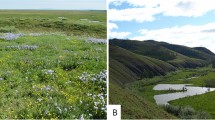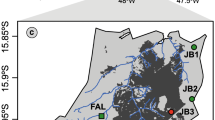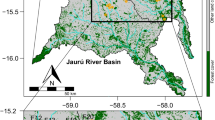Abstract
The structure of vegetation, and how this structure varies across a landscape, is crucial to understanding the distribution of wildlife species. Between 2002 and 2004, we sampled small mammal communities and measured vegetation structure at 185 locations across a range of disturbance regimes in a shortgrass prairie ecosystem in southeastern Colorado, USA. At each sampling location, the local disturbance regime was some combination of varying intensity of livestock grazing, military training activity, and fire. Vegetation structural characteristics measured included percent bare ground, basal cover, litter, shrub density, and mean grass and shrub height. Rodent communities were described by richness, diversity, total and per capita biomass, and species abundances. Northern grasshopper mice (Onychomys leucogaster), Ord's kangaroo rats (Dipodomys ordii), silky pocket mice (Perognathus flavus), western harvest mice (Reithrodontomys megalotis), white-footed mice (Peromyscus leucopus), southern plains wood rats (Neotoma micropus), thirteen-lined ground squirrels (Spermophilus tridecemlineatus), deer mice (Peromyscus maniculatus), and spotted ground squirrels (Spermophilus spilosoma) accounted for >99 % of all captures. Canonical correlation analysis was used to assess the relationship between small mammals and vegetation structure. The first two canonical variates explained over 50 % of the variation in vegetation structure and were related to the ratio of bare ground to basal coverage and litter accumulation. Rodent community indices were most strongly related to litter accumulation and shrub density, though the models had low explanatory power. Our results agreed with published findings regarding microhabitat associations and indicated small mammal communities benefited from a system of interacting disturbances and the resulting landscape mosaic.



Similar content being viewed by others
References
Bartholomew GA, Caswell HH (1951) Locomotion in kangaroo rats and its adaptive significance. J Mammal 32:155–169
Berlow EL, D’Antonio CM, Reynolds SA (2002) Shrub expansion in montane meadows: the interaction of local-scale disturbance and site aridity. Ecol Appl 12:1103–1118
Bock CE, Bock JH (1990) Effects of fire on wildlife in southwestern lowland habitats. In: Krammes JS, DeBano LF, M.J. Zwolinski MJ (eds) Effects of fire in management of southwestern natural resources: workshop proceedings. U.S. Forest Service, General Technical Report RM-191, Rocky Mountain Forest and Range Experiment Station, Fort Collins, Colorado, pp 50–64
Briggs JM, Knapp AK, Brock BL (2002) Expansion of woody plants in tallgrass prairie: a fifteen-year study of fire and fire-grazing interactions. Am Midl Nat 147:287–294
Brown JH, Liebermann GA (1973) Resource utilization and coexistence of seed-eating desert rodents in sand dune habitats. Ecology 54:788–797
Clark BK, Kaufman DW (1991) Effects of plant litter on foraging and nesting behavior of prairie rodents. J Mammal 72:502–512
Dale MR (1999) Spatial pattern analysis in plant ecology. Cambridge University Press, Cambridge
Davidson AD, Ponce E, Lightfoot DC, Fredrickson EL, Brown JH, Cruzado J, Brantley SL, Sierra-Corona R, List R, Toledo D, Ceballos G (2010) Rapid response of a grassland ecosystem to an experimental manipulation of a keystone rodent and domestic livestock. Ecology 91:3189–3200
Fleharty ED, Channell R (1997) Historical implications and characteristics of assemblages of small mammals in west-central Kansas. In: Yates TL, Gannon WL, Wilson DE (eds) Life among the Muses: papers in honor of James S. Findley. The Museum of Southwestern Biology, Special Publication 3, Albuquerque, New Mexico, pp 155–178
Harrison KA, Bardgett RD (2010) Influence of plant species and soil conditions on plant-soil feedback in mixed grassland communities. J Ecology 98:384–395
Henke SE, Bryant FC (1999) Effect of coyote removal on the faunal community in western Texas. J Wildl Manag 63:1066–1081
Hobbs RJ, Huenneke LF (1992) Disturbance, diversity, and invasion: implications for conservation. Conserv Biol 6:324–337
Johnson MD, Horn CM (2008) Effects of rotational grazing on rodents and raptors in a coastal grassland. West North Amer Nat 68:444–452
Jongman RHG, Ter Braak CTF, Van Tongeren OFR (1995) Data analysis in community and landscape ecology. Cambridge University Press, Cambridge
Kaufman DW, Kaufman GA (1989) Burrow distribution of the thirteen-lined ground squirrel in grazed mixed-grass prairie: effect of artificial habitat structure. Prairie Nat 21:81–83
Kaufman DW, Kaufman GA, Clark BK (2000) Small mammals in native and anthropogenic habitats in the Lake Wilson area of north-central Kansas. Southwest Nat 45:45–60
Knight DH (1994) Mountains and plains, the ecology of Wyoming landscapes. Yale University Press, New Haven
Leonard S, Kirkpatrick J, Marsden-Smedly J (2010) Variation in the effects of vertebrate grazing on fire potential between grassland structural types. J Appl Ecol 47:876–883
Longland WS, Price MV (1991) Direct observations of owls and heteromyid rodents: can predation risk explain microhabitat use? Ecology 72:2261–2273
Lyon LJ, Huff MH, Smith JK (2000) Fire effects on fauna at landscape scales. In: Smith JK (ed) Wildland fire in ecosystems: effects of fire on fauna. General Technical Report RMRS-GTR-42-vol.1, USDA Forest Service Rocky Mountain Research Station, Fort Collins, Colorado, pp 43–49
McGarigal K, Cushman S, Stafford S (2000) Multivariate statistics for wildlife and ecology research. Springer, New York
Milchunas DG, Schulz KA, Shaw RB (1999) Plant community responses to disturbance by mechanized military maneuvers. J Environ Qual 28:1533–1547
Milchunas DG, Schulz KA, Shaw RB (2000) Plant community structure in relation to long-term disturbance by mechanized military maneuvers in a semiarid region. Environ Manag 25:525–539
Morin PJ (1999) Community ecology. Blackwell Science, Malden
Otis DL (1997) Analysis of habitat selection studies with multiple patches within cover types. J Wildl Manag 61:1016–1022
Reed AW, Slade NA (2009) Environmental correlates of survival and reproduction in old-field rodents. J Mammal 90:680–685
Reed AW, Kaufman GA, Rintoul DA, Kaufman DW (2004) Influence of prey abundance on raptors in tallgrass prairie. Prairie Nat 36:23–32
Reed AW, Kaufman GA, Kaufman DW (2005) Rodent seed predation and GUDs: effect of burning and topography. Can J Zool 83:1279–1285
Rosenzweig ML (1973) Habitat selection experiments with a pair of coexisting heteromyid rodent species. Ecology 62:327–335
Schorr RA, Siemers JL, Lukacs PM, Gionfriddo JP, Sovell JR, Rondeau RJ, Wunder MB (2007) Using survival of rodents to assess quality of prairie habitats. Southwest Nat 52:552–563
Shaw RB, Diersing VE (1990) Tracked vehicle impacts on vegetation at the Piñon Canyon Maneuver Site, Colorado. J Environ Qual 19:234–243
Shaw RB, Anderson SL, Schulz KA, Diersing VE (1989) Plant communities, ecological checklist, and species list for the U.S. Army Pinon Canyon Maneuver Site, Colorado. Colorado State University Science Series 37, Fort Collins, Colorado
Sieg CH (1997) The role of fire in managing for biological diversity on native rangelands of the northern Great Plains. In: Conserving biodiversity on native rangelands: symposium proceedings. U.S. Forest Service General Technical Report RM-GTR-298, Rocky Mountain Range and Experiment Station, Fort Collins, Colorado, pp 31–38
Ter Braak CJF (1986) Canonical correspondence analysis: a new eigenvector technique for multivariate direct gradient analysis. Ecology 67:1167–1179
Thompson CM, Gese EM (2007) Food webs and intraguild predation: community interactions of a native mesocarnivore. Ecology 88:334–346
Turner MG, Gardner RH, O’Neill RV (2001) Landscape ecology in theory and practice. Springer, New York
Valone TJ, Kelt DA (1999) Fire and grazing in a shrub-invaded grassland community; independent or interactive ecological effects? J Arid Environ 42:15–28
VanNimwegen RE, Kretzer J, Cully JF Jr (2008) Ecosystem engineering by a colonial mammal: how prairie dogs structure rodent communities. Ecology 89:3298–3305
Webster DB, Webster M (1971) Adaptive value of hearing and vision in kangaroo rat predator avoidance. Brain Behav Evol 4:310–322
White EP, Ernest SKM, Thibault KM (2004) Trade-offs in community properties through time in a desert rodent community. Am Nat 164:670–676
Wiens JA (1989) Spatial scaling in ecology. Functional Ecol 3:385–397
Acknowledgments
Funding and logistical support were provided by the U.S. Army, Directorate of Environmental Compliance and Management, Fort Carson, Colorado, through the U.S. Fish and Wildlife Service, Colorado Assistance Office, Golden, Colorado, and the Utah Cooperative Fish and Wildlife Research Unit at Utah State University. Additional support was provided by the U.S. Department of Agriculture, Wildlife Services, National Wildlife Research Center at Utah State University, Logan, Utah. We thank T. Warren, B. Rosenlund, G. Belew, R. Bunn, D. Sharps, and M. Klavetter for logistical assistance and E. Joyce, J. White, E. Cleere, M. Watkins, D. Degeranno, A. Larkins, C. Roemer, D. Fletcher, W. Ulrey, S. Schopman, C. Gazal, A. Knipps, J. Garner, and C. Briggs for field assistance. We thank M. Conner, M. Ernest, J. MacMahon, and F. Provenza for review of the manuscript. Research protocols were approved by the Institutional Animal Care and Use Committees at the National Wildlife Research Center and Utah State University.
Author information
Authors and Affiliations
Corresponding author
Additional information
Communicated by: Karol Zub
Rights and permissions
About this article
Cite this article
Thompson, C.M., Gese, E.M. Influence of vegetation structure on the small mammal community in a shortgrass prairie ecosystem. Acta Theriol 58, 55–61 (2013). https://doi.org/10.1007/s13364-012-0098-5
Received:
Accepted:
Published:
Issue Date:
DOI: https://doi.org/10.1007/s13364-012-0098-5




